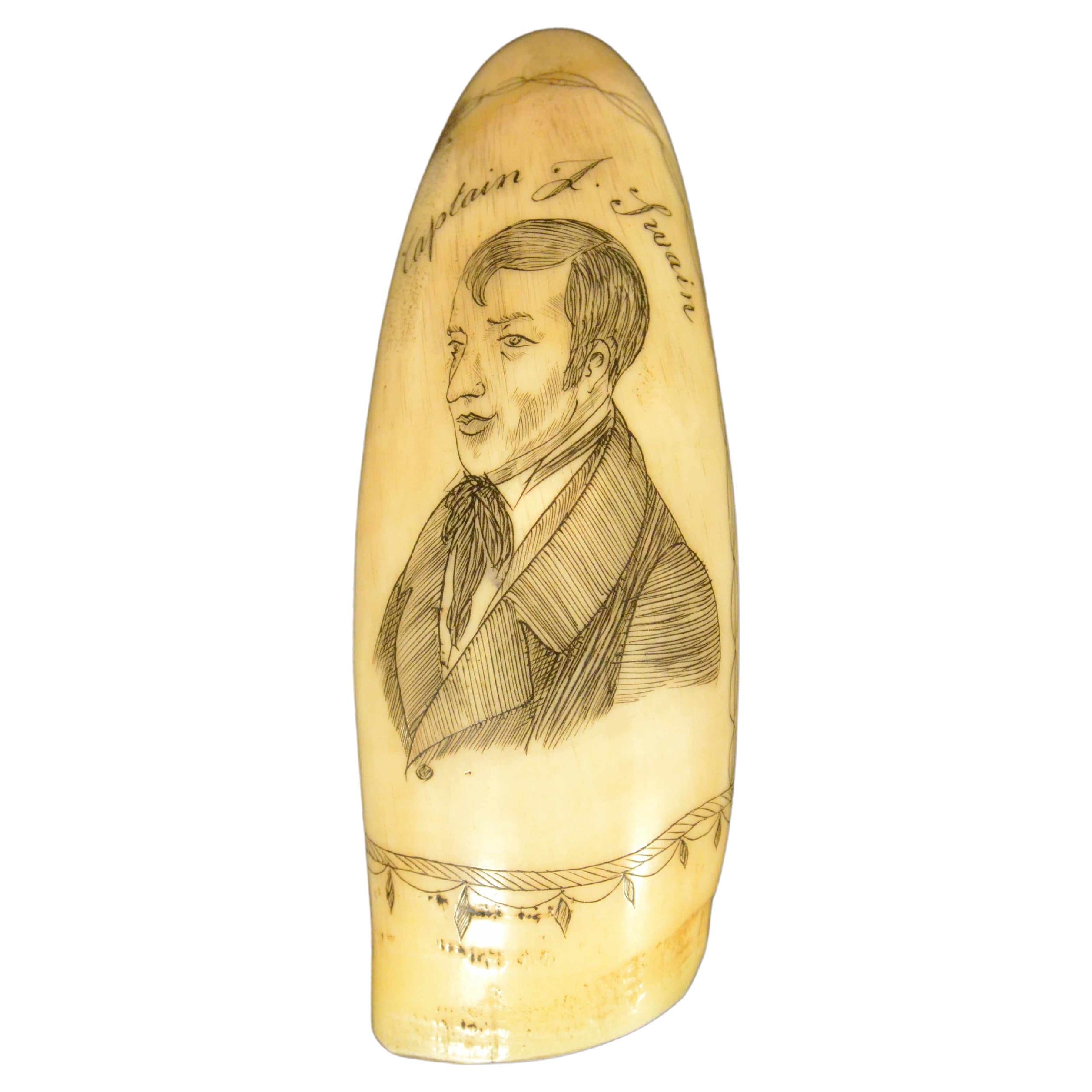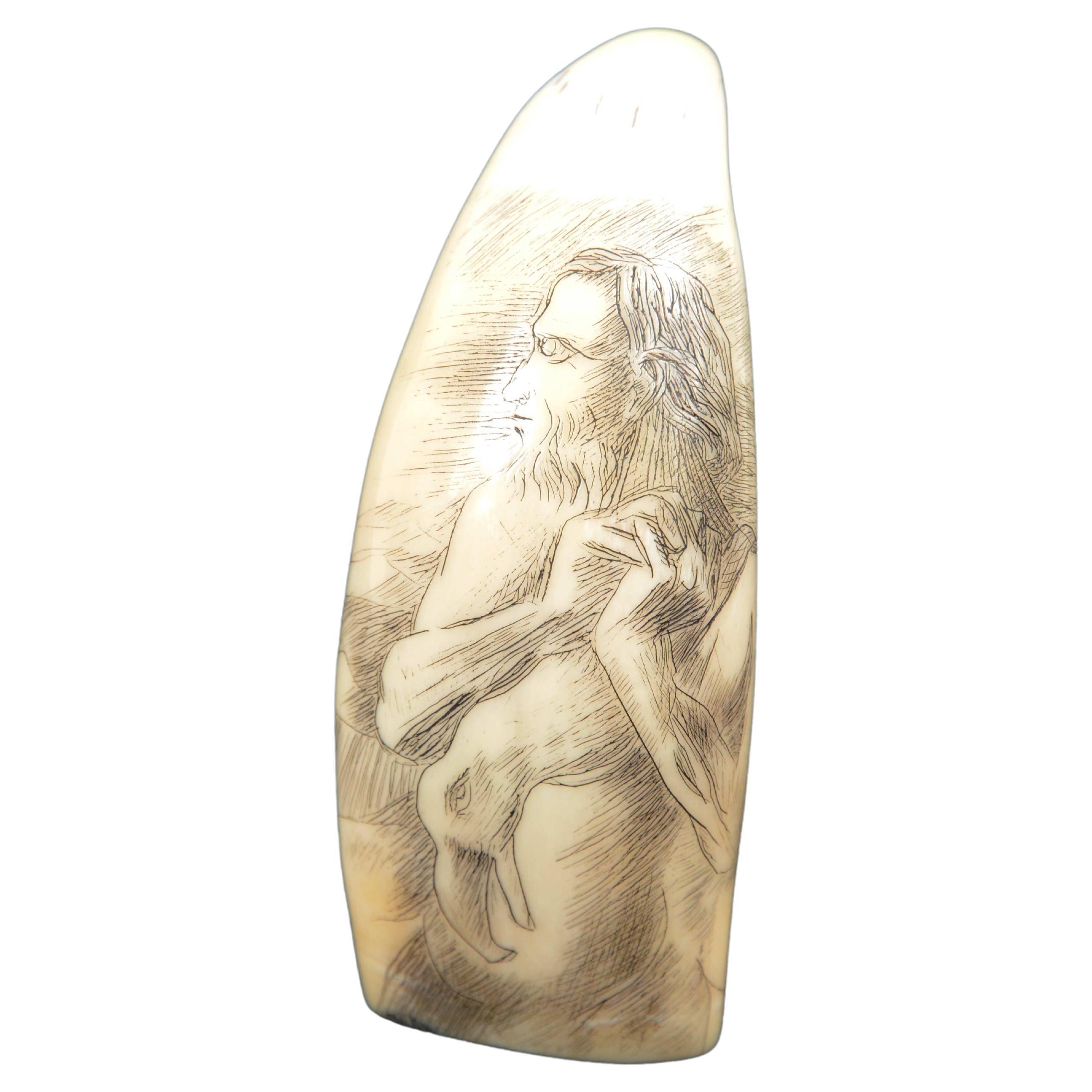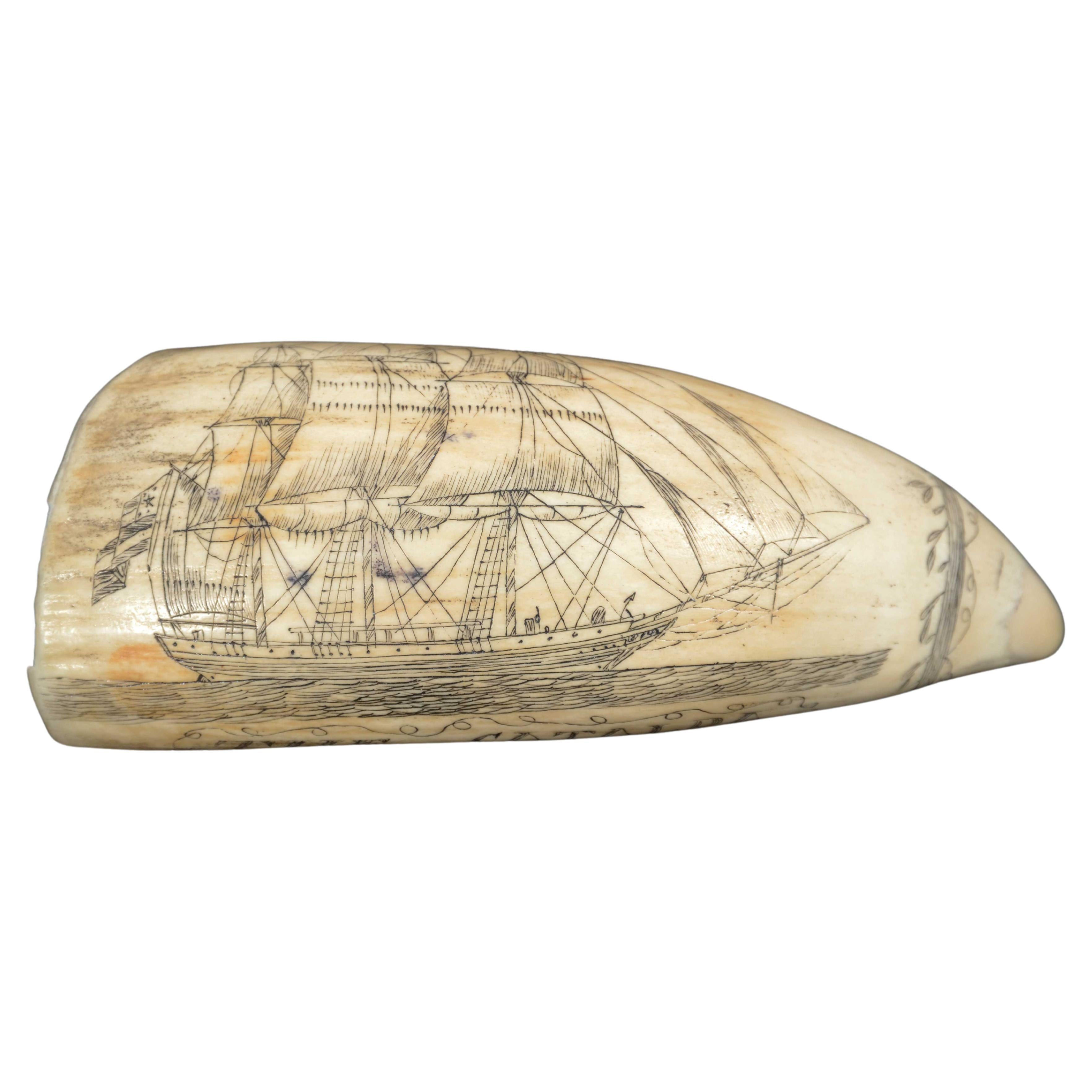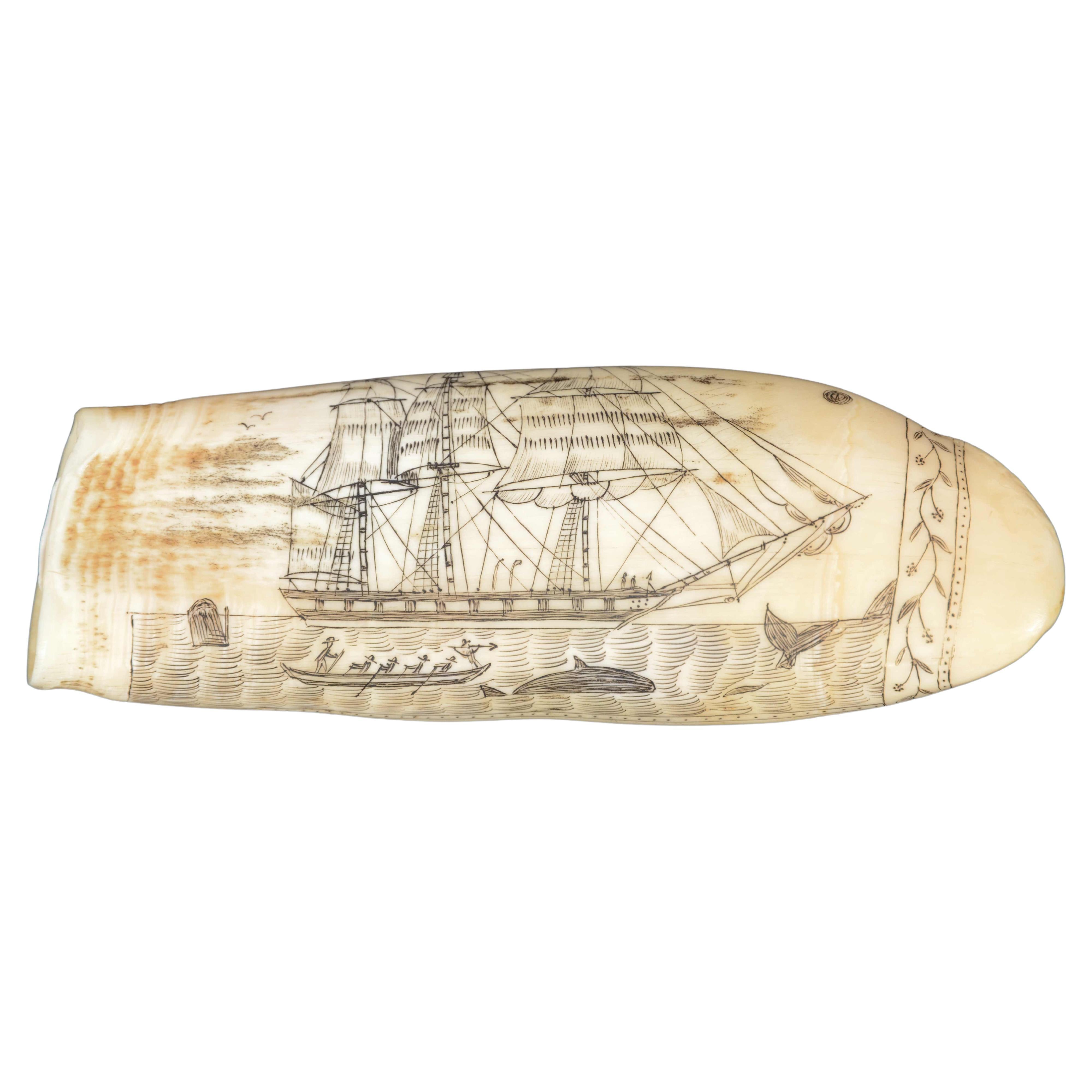Items Similar to Scrimshaw of whale tooth engraved with 1820s truncated pyramid cippus and Man
Want more images or videos?
Request additional images or videos from the seller
1 of 18
Scrimshaw of whale tooth engraved with 1820s truncated pyramid cippus and Man
About the Item
Scrimshaw of an engraved whale's tooth, depicting on one side, truncated pyramid cippus culminating with a half sphere and surmounted at the top by a six-pointed star, symbolism traceable to Freemasonry, and at the bottom the date 1820 and above the written TASMANIA.
The back depicts a half-bust of an elegantly dressed man and at the top the initials D.M.G.
Bon état. Measures 9x3x2 cm - inches 3.6x1.3x0.6.
The word scrimshaw refers to an art form (and the various products of this art) that developed aboard American whaling ships between 1745 and 1759 as a means of recreation to occupy time during the long hours aboard; this art form consisted of a process of carving and carving whale bones and teeth, with which a wide range of both everyday and ornamental objects were made, which were usually made as souvenirs for members of one's family. Nella scelta dei materiali il primo era sicuramente il dente d'avorio del capodoglio. Solo la punta del dente era liscia ed era necessario preparare il resto della superficie ruvida lucidandola. Il dente era ben immerso in acqua salata o calda, spesso con l'aggiunta di potassio. Quindi veniva utilizzata una lima per strofinare e arrotondare la superficie, e infine una carta vetrata fine per completare il processo. L'ultima fase della lucidatura veniva eseguita con pomice o cenere e poi il dente veniva strofinato ancora con il palmo della mano. Each step had to be performed very slowly so as not to affect the smooth surface of the tooth. In terms of subjects for scrimshandering, the most common were a drawing of a ship or scenes of cetacean capture, made with a needle or knife, or an appropriate blade: for example, thanks to Herman Melville we know that some whalers had boxes of dentist's tools specially designed for scrimshandering. The origin of scrimshandering, as the whalers called it, i.e., the art of making scrimshaw, is a mystery: theories range from locating its origin in Eskimo culture or with Native Americans to emphasizing the influence of South Sea islanders. La spiegazione di Edouard A. Stackpole (1903 -1993), giornalista americano, scrittore e storico di caccia alle balene, è forse la più plausibile: lo scrimshaw sarebbe stato semplicemente lo sviluppo marittimo dell'antica arte di intagliare l'avorio, così come era stata praticata per secoli, e in quanto forma d'arte popolare non sarebbe stato altro che un adattamento da parte dei balenieri americani di un antico mestiere.
- Dimensions:Height: 3.6 in (9.15 cm)Diameter: 1.3 in (3.31 cm)
- Materials and Techniques:Teeth
- Period:
- Date of Manufacture:1820
- Condition:Wear consistent with age and use.
- Seller Location:Milan, IT
- Reference Number:1stDibs: LU1020237660702
About the Seller
4.9
Vetted Seller
These experienced sellers undergo a comprehensive evaluation by our team of in-house experts.
Established in 1999
1stDibs seller since 2014
370 sales on 1stDibs
Typical response time: <1 hour
- ShippingRetrieving quote...Ships From: Milan, Italy
- Return PolicyA return for this item may be initiated within 14 days of delivery.
More From This SellerView All
- Scrimshaw of engraved whale tooth depicting the Captain F. Swain 1850Located in Milan, ITScrimshaw of an engraved whale tooth, depicting on one side the half-bust of the smartly dressed and handsome Captain F. Swain. On the Back the inscription Master The WHALER SWAN f...Category
Antique Mid-19th Century Nautical Objects
MaterialsTeeth
- 7990 Scrimshaw of vertically engraved whale tooth dated around 1850Located in Milan, ITScrimshaw of a vertically engraved whale tooth datable to around the mid-19th century depicting an old sailor with a beard and long hair holding leaning over one shoulder a cormoran...Category
Antique 1850s Nautical Objects
MaterialsTeeth
- Scrimshaw of excellently made engraved whale's tooth dated around 1850Located in Milan, ITScrimshaw of an engraved and beautifully crafted whale tooth dated around the mid-19th century depicting vessel with full sails under sail, on the back a lady in a long dress with in...Category
Antique Mid-19th Century Nautical Objects
MaterialsTeeth
- Scrimshaw of vertically engraved whale tooth valuable workmanship dated 1882Located in Milan, ITScrimshaw of a vertically engraved whale tooth, of fine workmanship dated 1882, length 12 cm - inches 4.8. The tooth depicts: 6 whalers in rowboat trying to harpoon a whale and whal...Category
Antique 1880s Nautical Objects
MaterialsBone
- Engraved whale tooth scrimshaw of fine workmanship datable around 1850Located in Milan, ITScrimshaw of an engraved whale tooth, fine workmanship datable to around mid-19th century, length 11.7 cm, depicting whaler with men aboard, boat rowing with 6 whalers one of them i...Category
Antique 1850s Nautical Objects
MaterialsTeeth
- Scrimshaw of engraved whale tooth depicting naked woman with very 1850s faceLocated in Milan, ITScrimshaw of an engraved whale tooth, depicting naked woman with a very end, with long hair and turgid breasts flying the American flag, on the back large vessel with sails unfu...Category
Antique Mid-19th Century Nautical Objects
MaterialsTeeth
You May Also Like
- 1820s Tyrolean Tole Polychrome-Painted Tin Man Colonial Gentleman FigureLocated in Hyattsville, MDVery rare painted metal figure. Absolutely stunning. It stands up fine and displays well. 14 inches tall. German or Italian made. In poor vintage condition; one foot is completel...Category
Antique 1830s European Early Victorian Historical Memorabilia
MaterialsTin
- 1820s George III Mahogany BarometerLocated in Chapel Hill, NC1816-1829 barometer by Cetti & Co, 25 Red Lion St., Holburn, London. Mahogany with conch shell & rosette inlays. George III period. Not currently working. The original finial is fire...Category
Antique 1820s English George III Scientific Instruments
MaterialsMahogany, Giltwood
- 19th Century Irish Folk Art Whale ToothLocated in Coeur d'Alene, IDIrish Folk Art. This sperm whale tooth was etched during the 19th century, in Ireland. There'sa a drinking sailor on one side, and a barmaid on the other -...Category
Antique Late 19th Century Northern Irish Nautical Objects
MaterialsOther
- Framed 1820s Hand Colored Map of the United StatesLocated in Stamford, CTFramed 1820s hand colored map photos of North America and South America. As found framed in giltwood frame.Category
Antique 1820s American Spanish Colonial Maps
MaterialsGiltwood, Paper, Glass
- 1820s 3 Volume Family Bible Commentary by Mathew HenryLocated in Tarrytown, NY1820s Mathew Henry leather bound bible commentary. 3 Volume set. Gilt pages.Category
Antique 1820s Books
MaterialsPaper
- Rare Scrimshaw Decorated HornLocated in Lymington, HampshireA rare scrimshaw decorated horn, engraved over one side with the Royal Arms countersigned and titled ship profiles for the Great Eastern, the Great Britain,...Category
Antique 1860s English Nautical Objects
MaterialsHorn
Recently Viewed
View AllMore Ways To Browse
Compensating Binnacle
Nautical Cast Iron
John Hastie
Huge Natural Clam Shell
Iron Pulley
Whales Tooth Scrimshaw
Antique Fishing Reels Uk
Antique Nautical Pocket Compass
Boatswain Whistle
Clams Shell Bird Bath
Joe Selby
Nautical Sampson Post Cleats
Negretti & Zambra On Sale
Pair Of Ww11 Observation Binoculars
Portuguese Barometer
Nord Sud
Vintage Pump Handle
Us Navy Compass





